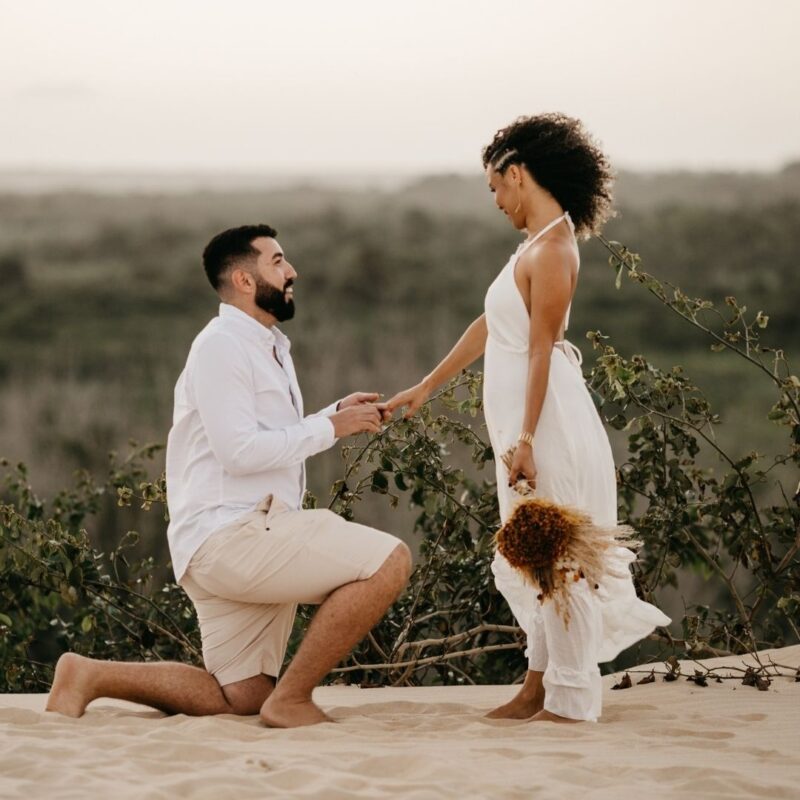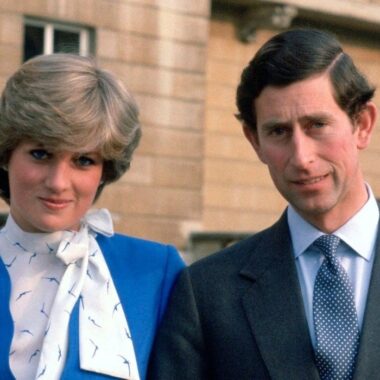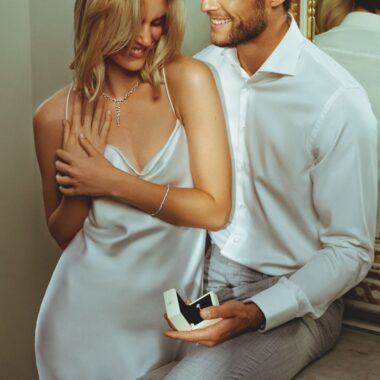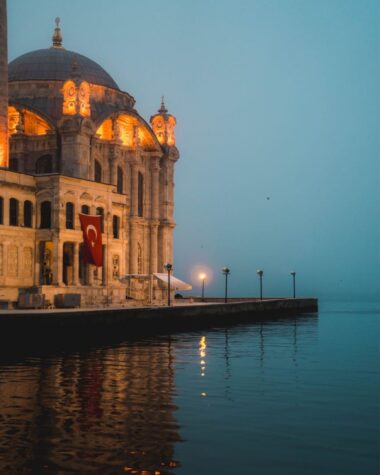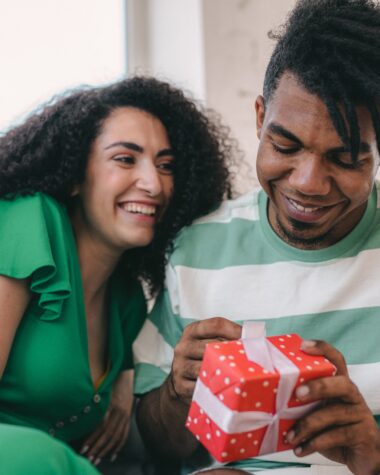Engagement has a long history, which dates back to ancient times. Back then, love was less important to a life-long commitment, with social status, property ownership, and power playing the more decisive role. Engagement and marriage were often more strategic in nature, with people only marrying within their own social standing. As such, in ancient times the engagement ring, then a simple metal ring, was not considered a token of love, but rather a confirmation of the receipt of the dowry prior to the wedding.
Since when have diamond engagement rings been a custom?
An engagement ring with a diamond is considered a central component of a classic engagement. Traditionally this is a solitaire ring, with a single, particularly beautiful stone. Conservative in design, the clear precious stone sparkles as the centrepiece of the ring.
The first engagement ring that bore a certain similarity to modern-day rings dates back to the year 1477. Archduke Maximilian of Austria gifts an engagement ring with an “M” formed of diamonds to his beloved, Maria von Burgund. Modern grinding techniques did not yet exist, and so, the diamonds were actually fragments – diamond slivers set alongside one another.
Previously a piece of jewellery that would have been unaffordable for normal people, the engagement ring only became mainstream in the 20th century. In the 1940s and 1950s, the first Hollywood stars sought to stand out from the crowd with diamond engagement rings, while at the same time, the legendary “A Diamond is forever” advertising campaign was launched by the most powerful company within the diamond sector, De Beers. Beginning in the USA, the diamond engagement ring began its triumphal procession all around the world, become a standard part of the classic engagement.
Even today, the solitaire in a traditional claw setting on a ring of gold or platinum remains the symbol of an engagement ring. Everyone instantly recognises a ring like this as an engagement ring.
Where should I propose?
There are almost endless possibilities when it comes to planning a marriage proposal, however, there are some classic options that have proven successful. There is no need to reinvent the wheel and arrange a particularly exotic proposal – there are ideals that have proven effective a million times over.
The marriage proposal in a restaurant is right at the top of the list of the most popular engagement traditions. Dressed appropriately for the occasion, you take your loved one to a very good restaurant, and propose by candlelight over an elegant evening meal. Romance, fine food – the perfect environment for a proposal. Traditionally, pink roses are the first choice when it comes to table decorations, as they represent blossoming love.
The home proposal has also proven effective time and again, as you cannot be interrupted within your own four walls, and can plan the shared moment exactly as you want it.
Going down on one knee is an essential element
According to tradition, it is the man who proposes to the woman, and therefore it is he who goes down on one knee, with one knee on the floor and the other bent. The origins of this gesture, which is intended as an expression of respect and loyalty, probably date back to the Middle Ages. At the time, knights would kneel before their king as a demonstration of their loyalty towards him.
Going down on one knee still remains a fixed component of most marriage proposals – the man goes down on one knee and asks the question: “Will you marry me?” or “Will you be my wife?”. She, in turn, responds with a “Yes”, before he places the engagement ring on her ring finger. In the UK, Germany, and Austria the ring finger is on the left hand, while in Switzerland and the USA the ring finger is on the right hand.
What about asking for the bride’s hand?
This doesn’t refer to placing the engagement ring onto the bride’s finger or actually popping the question, asking for the bride’s hand has a different background. It used to be the case that, for an engagement to be valid, the man had to ask his potential bride’s father for his daughter’s hand prior to the engagement. Without the consent and permission of the parents, it was inconceivable that their children could become engaged or marry.
Those who want a very traditional engagement and first want to show a gesture of respect towards their loved one’s parents, still adhere to this custom. Of course, it is no longer necessary to ask for permission, however, the custom of taking a small gift to the parents’ door in order to ask for the woman’s hand is still looked upon in a positive light within more conservative families. A positive relationship with your future in-laws is always a good idea, as every engagement and subsequent marriage involves two families coming together.
Do I have to arrange an engagement party?
The classic marriage proposal takes place when the two partners are alone together, with the engagement then made public with an announcement in the newspaper. People often forgo this tradition nowadays, with increasingly fewer people holding a subscription for a daily newspaper. One very nice alternative is to make the announcement with a printed card, which is sent to friends and family. If you already have a wedding date in mind, you can also combine this engagement announcement with a “Save the Date” card.
Those who are impatient can feel free to share their news over the phone, especially within the immediate family circle. Nowadays engagements can also be announced electronically, whether via email or WhatsApp.
An engagement party, either immediately after the proposal or at a later point in time, is not essential, and is not a fixed tradition (at least within the German-speaking world), however, your family, friends, and relatives will no doubt be delighted to celebrate this major milestone in your relationship with you. If an engagement party is arranged, the couple will generally forego a separate hen or stag party before the wedding.
